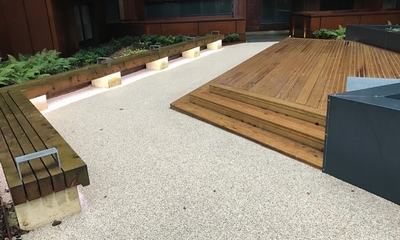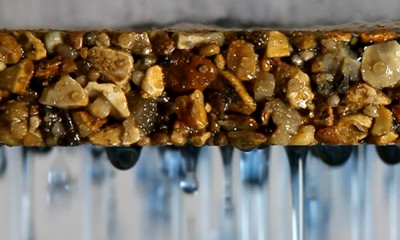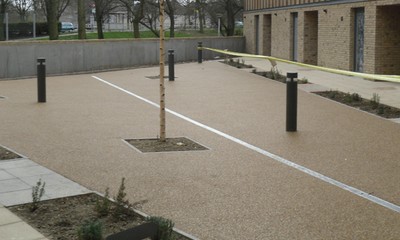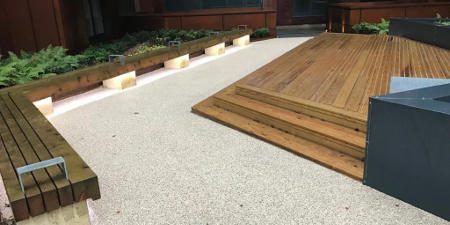 One of the biggest challenges with the speed of urban development is the strain on drainage. Domestic toilets, showers and sinks, commercial kitchens and bathrooms, contractor waste, and surface water from rainfall – that’s a lot of pressure on drainage systems.
One of the biggest challenges with the speed of urban development is the strain on drainage. Domestic toilets, showers and sinks, commercial kitchens and bathrooms, contractor waste, and surface water from rainfall – that’s a lot of pressure on drainage systems.
To make matters worse, surface and foul drainage are often combined, and even when separated often end up discharging into a combined sewer. Add heavy rainfall to this and treatment systems often struggle to cope, causing contaminated water overflow.
Sustainable drainage systems (SuDS) are a natural approach to manage drainage in urban developed or developing areas. They work by slowing down the water run-off and allowing natural processes to break down pollutants.
There are three main areas to consider when deploying SuDS: rainwater should be encouraged to infiltrate into the local surface area; surface water run-off from development should be free from pollution; and the rate of water flow of surface water run-off should not be greater than that of an equivalent undeveloped area. So where should developers start?
SuDS-compliant paving
The permeable nature of SuDS-compliant paving enables water to flow naturally into groundwater or to be diverted to a soakaway if drainage is poor, as opposed to traditional impervious paving which is laid to incorporate gullies or slot drainage with pipework situated below the ground and connected to a sewer system.
There are various options for paving, including blocks with open or coarse aggregate-filled joints or gravel-filled concreate paving, which is semi-permeable. The use of resin-bound surfacing is increasingly popular too, and enables surface water to drain rather than run-off; dramatically reducing the likelihood of surface flooding or sewer overflow. Additional benefits of resin-bound surfacing are that it has a decorative finish, is UV resistant and will therefore not degrade upon exposure to the elements, and that it is low maintenance – all ideal attributes when dealing with an urban area.
As another surface option that will enable water to flow away naturally, grass is an effective alternative.
Solutions below the ground
 There are various below-ground drainage solutions – such as soakaways, infiltration trenches and filter drains – which allow the gradual release of water into a sewerage system or into the ground. Water may well be piped from a remote location such as an area of impervious paving. To fill underground voids, plastic honeycomb units wrapped in geotextile are used to create voids where water can be held. For a soakaway, it’s a good idea to fill the trench with coarse aggregate or rubble, that can also be heightened with the addition of a geotextile lining. An infiltration trench is similar to a soakaway, while a filter drain is an infiltration trench with a horizontal pipe to assist water flow.
There are various below-ground drainage solutions – such as soakaways, infiltration trenches and filter drains – which allow the gradual release of water into a sewerage system or into the ground. Water may well be piped from a remote location such as an area of impervious paving. To fill underground voids, plastic honeycomb units wrapped in geotextile are used to create voids where water can be held. For a soakaway, it’s a good idea to fill the trench with coarse aggregate or rubble, that can also be heightened with the addition of a geotextile lining. An infiltration trench is similar to a soakaway, while a filter drain is an infiltration trench with a horizontal pipe to assist water flow.
Solutions above the ground
While a flood plain is designed to remain dry except in the case of heavy rainfall, a pond or basin is designed to hold water above the ground. There are additional tools in this area, such as balancing and attenuation ponds, which feature the fluctuation of water levels to reduce the likelihood of flooding, while retention ponds retain water for slightly longer periods of time, to improve the water quality and enable the treatment of effluent from septic tanks or sewage treatment units.
Filter strips and swales
 By keeping areas of ground near a site covered in vegetation which absorbs runoff water from nearby hard surfaces, filter strips can be very effective. Swales too can make a difference – these resemble long, shallow ditches and can carry waste water to another location. This re-routing of water also enables it to go through a level of filtration, ensuring pollutants can be removed.
By keeping areas of ground near a site covered in vegetation which absorbs runoff water from nearby hard surfaces, filter strips can be very effective. Swales too can make a difference – these resemble long, shallow ditches and can carry waste water to another location. This re-routing of water also enables it to go through a level of filtration, ensuring pollutants can be removed.
Regulating SuDS
There are many permissions and approvals needed for a SuDS project. These are all detailed in the CIRIA SuDS Manual, but essentially include the need for planning permission and building approval (where a SuDS system is being used to encourage water run-off). The sewerage undertaker must also approve the connections to adjoining sewers and systems that are to be adopted. There are also slip-resistant standards to be adhered to, as specified in BS 7976. The Health and Safety Executive recommends pendulum slip testing as part of risk assessment protocols. As well as the HSE, advice can be sought from local authorities, the Environment Agency, the Scottish Environmental Protection Agency, CIRIA, and the Highways Authority.

Contact Limegate
Give us a call on 01959 546 208 or email to ask us any questions about our services.


